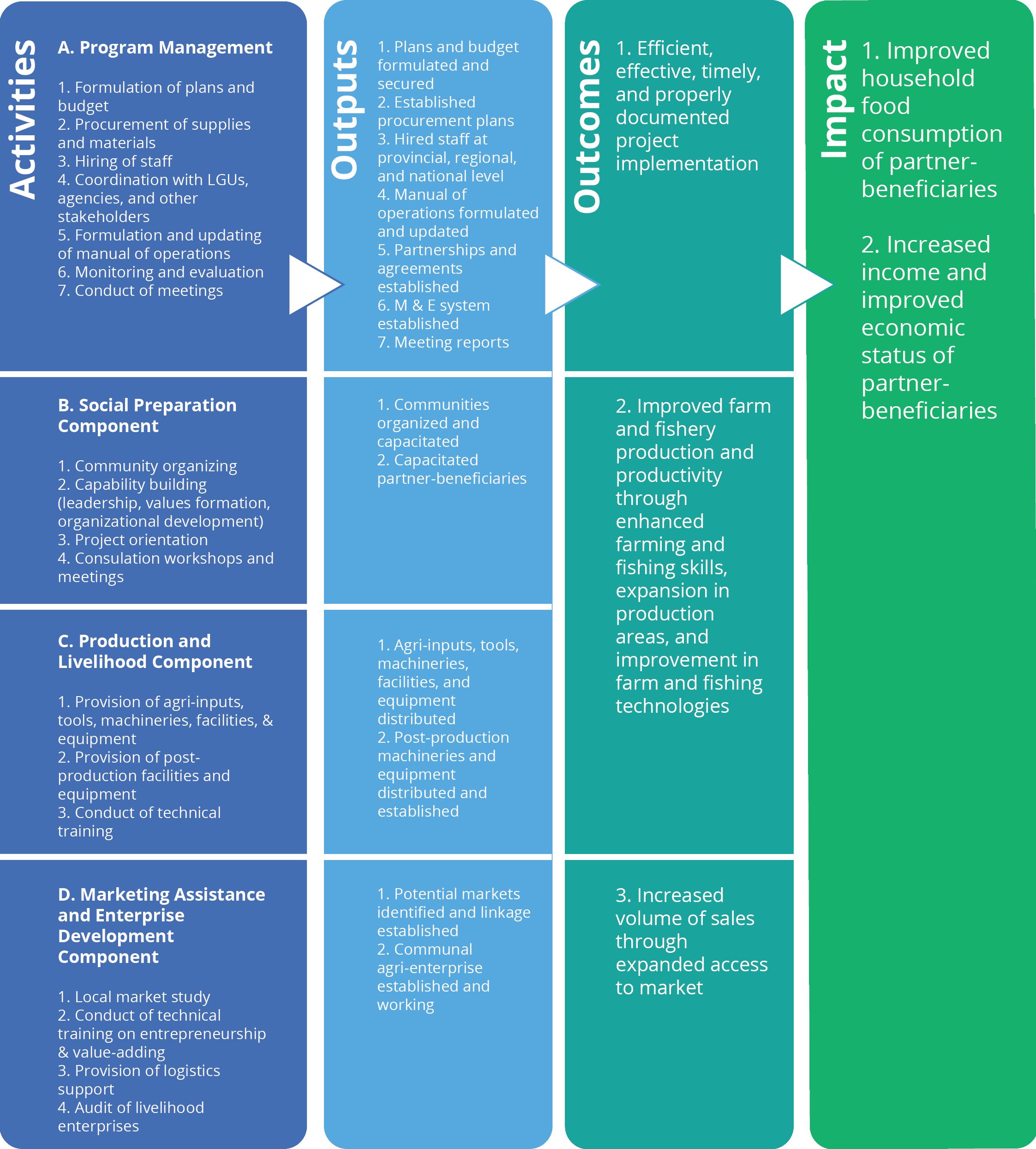Vision
SAAD envisions socio-economically empowered farmer and fisher groups who are active actors in agricultural development and nation-building.
Mission
We contribute to poverty reduction among the identified marginalized communities in the country through Social preparation that empowers rural farmers and fisherfolk; Intensified Production, Livelihood, Marketing Assistance, and Enterprise Development interventions responsive to assessed needs; and Synergistic actions with the local government units, private sector, other government agencies, and stakeholders
About the SAAD Program
The Special Area for Agricultural Development (SAAD) Program of the Department of Agriculture (DA) is primarily aimed at reducing poverty and enhancing local agricultural production through livelihood assistance for marginalized Filipino farmers and fishers. The program is committed to improving the economic conditions of underprivileged communities by providing opportunities in the agriculture and fisheries sectors.
SAAD Phase 1
SAAD was conceptualized by former DA Secretary Emmanuel F. Piñol and launched in 2016 as an intervention to alleviate poverty in remote rural areas inhabited by underrepresented communities. The program initially identified and targeted the ten (10) poorest provinces in the Philippines each year, using poverty incidence data from the Philippine Statistics Authority (PSA) (2012 and 2015). In 2019, conflict-affected areas were also included under Executive Order No. 70 (ELCAC – End Local Communist Armed Conflict).
In 2019, the leadership transitioned to DA Secretary William D. Dar, who introduced the New Thinking for Agriculture, focusing on a food-secure Philippines and prosperous farmers and fishers. His eight (8) paradigms strengthened SAAD’s implementation, aligning with the Plant, Plant, Plant Program under the slogan “Masaganang Ani at Mataas na Kita.”
SAAD National Program Management Office (NPMO)
The SAAD National Program Management Office (NPMO) oversees the program’s execution and operates under the leadership of:
- Mr. Lerey A. Panes (2017)
- Ms. Bernadette F. San Juan (2017-2019)
- Dr. Myer G. Mula (2019-2022)
- Mr. Ulysses J. Lustria Jr. (2022 – present)
The NPMO is structured into four primary clusters:
- Administrative and Procurement
- Planning, Monitoring, and Evaluation
- Public Relations and Communications
- Information Technology Sub-unit
These clusters are responsible for policy formulation, planning, budgeting, monitoring, and evaluation, ensuring the program’s effective execution across regional and provincial support units.
Achievements of Phase 1 (2017-2022)
SAAD Phase 1 successfully covered 440 municipalities and 27 cities in 11 regions, implementing 3,602 agricultural and fisheries projects. The program assisted:
- 143,520 individual beneficiaries
- 6,319 farmers and fishers’ cooperatives and associations (FCAs)
- 179,088 FCA members
Phase 1’s primary impact was measured based on household food consumption, emphasizing its core objective of ensuring “food on the table.” Despite budget limitations, the program successfully established policies, procedures, and localized operations to facilitate effective project execution.
SAAD Phase 2 (2023-2028)
Building upon the success of Phase 1, SAAD Phase 2 continues with the same core objectives, focusing on poverty reduction through four (4) primary components:
- Social Preparation
- Involves assessing the social and economic needs of target beneficiaries through profiling, capacity-building activities, and participatory rural appraisals.
- Food Production and Livelihood
- Provides agricultural and fisheries livelihood projects designed to transform beneficiaries into productive entrepreneurs.
- Marketing Assistance and Enterprise Development
- Supports beneficiaries in expanding their livelihood projects into sustainable agri-fisheries enterprises to improve income and economic status.
- Program Management
- Ensures the timely and quality delivery of goods and services through efficient procurement and implementation strategies.
Expanded Coverage and Objectives
SAAD Phase 2 expands its reach by focusing on 619 municipalities in 56 provinces identified as 5th-6th income class areas and among the top third most marginalized based on poverty incidence (excluding BARMM). The selection criteria were based on:
- PSA 2018 Small Area Estimates
- Department of Finance (DOF) Order No. 23-08
Unlike Phase 1, which emphasized food security, Phase 2 aims to transform beneficiaries from mere food producers to agri-entrepreneurs. This involves:
- Adoption of modern farming and fishing technologies
- Incorporation of product development and value addition
- Strengthening sustainability through marketing support
Conclusion
The SAAD Program remains steadfast in its commitment to improving the lives of marginalized farmers and fishers. From its inception in 2016 to its current Phase 2 implementation, SAAD continues to drive poverty alleviation, agricultural productivity, and economic empowerment across the Philippines. By integrating social preparation, livelihood support, enterprise development, and efficient program management, SAAD envisions a self-sustaining and progressive future for Filipino farmers and fisherfolk.
SAAD Logo
The SAAD (Special Area for Agricultural Development) logo embodies the program’s commitment to uplifting marginalized agricultural communities. At its core, the logo features a group of farmers, symbolizing the people at the heart of SAAD’s initiatives. The farmers are depicted in varying shades to represent diversity and inclusivity, with a deliberate inclusion of a woman to emphasize gender equality in the program’s scope.
Beneath the farmers, two foundational elements highlight SAAD’s dual-sector focus:
- Terraced farmland, representing the unique landscapes and farming communities that benefit from SAAD’s agricultural interventions.
- A fish head, symbolizing the fisheries sector and its role in rural development.
Surrounding these elements are four yellow curved lines, resembling outstretched arms, which represent SAAD’s four major components:
Social Preparation
Production and Livelihood Interventions
Marketing Assistance and Enterprise Development
Program Management
The hands depicted in the logo symbolize guidance, outreach, and support, reinforcing SAAD’s mission to empower rural communities. The cogs incorporated into the design reflect the core goal of sustainable progress, emphasizing the transformation of livelihood projects—from securing food on the table to thriving agribusinesses that foster long-term economic development.
